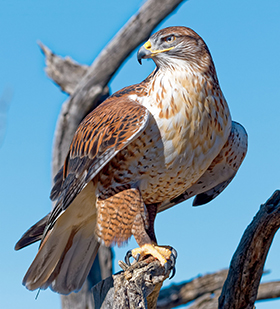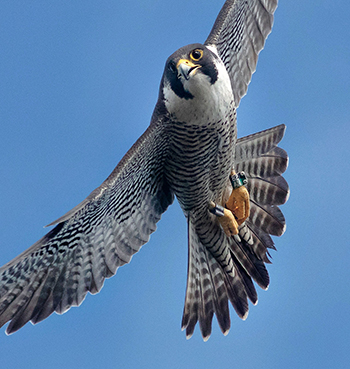
Audubon Adventures

Background for Teachers
Across time and place, raptors have seized and flown away with the human imagination. Hawks, owls, falcons, and other birds of prey populate mythology worldwide. Eagles in Greek myths carried thunderbolts in their talons, while Native American “Thunderbirds” ruled lightning in North America. Egyptians worshipped deities in the form of falcons. Following this tradition, the newly fledged United States of America chose the Bald Eagle as the nation’s symbol.
 The Tools of the Hunter
The Tools of the Hunter
Raptors snare these symbolic roles thanks to the same adaptations that make them such formidable predators. Eagles, hawks, and other raptors that are active in daytime scan the world with piercing eyes that endow them with a fierce, regal look. They fly on powerful wings and are equipped with hooklike talons and razor-sharp beaks. When a raptor takes to the air, small creatures on the ground freeze or hide!
Raptors aren’t the only predators among birds, of course. Roadrunners tackle snakes, and herons spear fish. The Loggerhead Shrike, a songbird, earns its nickname “butcher bird” for its habit of killing birds, mice, lizards, and large insects with its hooked bill and impaling them on thorns to feed on later. Even tiny songbirds take prey in the form of insects.
What makes raptors unique is the way they use their feet to catch and kill prey. The feet of a typical raptor are adapted for grasping and holding. It kills by squeezing with its strong feet and sharp talons. It maintains its grip with less effort than expected because tendons in the foot and leg are ridged in a way that makes them work like a ratchet, virtually locking the toes in place. This grip is so tenacious that a raptor may have to work to release it! Ospreys, for example, have been known to drown rather than let go of an extra-heavy fish.
The Osprey’s toes are a good example of how raptor feet have evolved to make them even better suited to a particular task. The bottoms of an Osprey’s toes are covered with spiky projections, which help them grip slippery, wriggling fish. An Osprey can also swivel one of its toes backward, enabling it to hang on to a fish even more firmly. The toes and legs of woodland raptors, such as Cooper’s Hawks, are long and narrow, perfect for catching songbirds and reaching into leafy shrubs. A Great Horned Owl’s powerful toes and hooked talons enable it to seize mammals ranging in size from mice to skunks.
Challenges, Then and Now
Despite admiration of raptors for their perceived bravery and ferocity (and, in some cultures, of owls as emblems of wisdom), persecution of raptors has often been intense. Raptors were once routinely shot as pests, with some species, such as Northern Goshawks, Cooper’s Hawks, and Sharp-shinned Hawks, considered vermin because they stole juvenile poultry. Bounties were offered for killing them. Others were shot purely for amusement. Hawk Mountain Sanctuary in Pennsylvania, the world’s first raptor refuge (established in 1934), was once a hotspot for locals to come and shoot migrating hawks by the thousands.

River of Raptors
Raptors typically avoid migrating over large bodies of water. They also tend to use thermal columns and other updrafts, such as those created by mountains and sometimes tall buildings, to save energy while flying. As a result, migrating raptors follow aerial highways that, in a few places, funnel many birds through small areas at the same time.
This behavior makes for spectacular sights as concentrations of raptors soar and swirl overhead during spring and fall migration at key points, such as New Jersey’s Cape May Peninsula, Pennsylvania’s Kittatinny Ridge, and Michigan’s Keweenaw Peninsula. A huge river of raptors also pours through Veracruz, Mexico, every fall, when four to six million raptors wing their way south through this bottleneck. Here, every day community scientists and other raptor-watchers can spot hundreds of thousands of Swainson’s Hawks, Ospreys, Mississippi Kites, Broad-winged Hawks, and Merlins wheeling overhead. And besides migrating raptors, tens of thousands of songbirds and migrating butterflies pass through these areas as well.
Today, laws protect raptors from such persecution in North America, and human efforts have even reestablished species that were once on the verge of extinction. The Peregrine Falcon, for example, nearly died out in the contiguous United States in the mid-twentieth century. The widespread use of DDT after World War II caused falcons (which ate birds that had eaten poisoned insects) to lay thin-shelled eggs that often cracked during incubation. Banning DDT as well as breeding and releasing captive-reared falcons back to the wild brought the species back from the brink of extinction.
Other pressures, however, continue to pose threats to raptors’ survival. These threats include habitat loss in both breeding and wintering ranges. Climate change may also alter habitats and prey supply for raptors. Pesticides and other pollutants still end up in raptors’ bodies, sometimes to lethal effect. In the mid-1990s, for example, tens of thousands of Swainson’s Hawks perished on their wintering grounds in Argentina after feeding on pesticide-laced locusts.
Appreciating and Helping Raptors
Fortunately, today raptors are widely appreciated for their role as top predators, especially as people learn how the food choices of many raptor species help farmers. A study of Barn Owls in an area of Florida, for example, showed that cotton rats formed about 60 percent of their diet. Cotton rats devour sugarcane and cost farmers millions of dollars annually, so by encouraging owls to nest and roost, the farmers would benefit from free—and environmentally friendly—pest control.
Raptor-watching has caused people not only to admire these aerial predators but also to participate in community-science efforts to track their migration and monitor their nests. For example, in Maitland, Florida, the Audubon Center for Birds of Prey rescues and rehabilitates 600 to 800 injured raptors annually. The center also manages a program called EagleWatch. Volunteers monitor urban eagle nests throughout Florida to gather data on nest productivity, locate new nests, and protect nests from threats such as illegal development.
Photos: (t to b) Jim Verhagen; Shlomo Neuman/Audubon Photography Awards.




